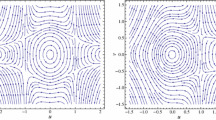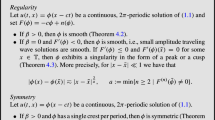Abstract
We study the spectral stability of small-amplitude periodic traveling waves of the Ostrovsky equation. We prove that these waves exhibit spectral instabilities arising from a collision of pair of non-zero eigenvalues on the imaginary axis when subjected to square-integrable perturbations on the whole real line. We also list all such collisions between pairs of eigenvalues on the imaginary axis and do a Krein signature analysis.



Similar content being viewed by others
Data Availability Statement
Data sharing is not applicable to this article as no datasets were generated or analyzed during the current study.
References
Bronski, J.C., Johnson, M.A.: The modulational instability for a generalized Korteweg-de Vries equation. Arch. Ration. Mech. Anal. 197(2), 357–400 (2010)
Creedon, R., Deconinck, B., Trichtchenko, O.: High-frequency instabilities of the Kawahara equation: a perturbative approach. SIAM J. Appl. Dyn. Syst. 20(3), 1571–1595
Deconinck, B., Trichtchenko, O.: High-frequency instabilities of small-amplitude solutions of Hamiltonian PDES. Discrete Contin. Dyn. Syst. Ser. A 37(3), 1323–1358(2017)
Gilman, O.A., Grimshaw, R., Stepanyants, Yu. A.: Approximate analytical and numerical solutions of the stationary Ostrovsky equation. Stud. Appl. Math. 95(1), 115–126(1995)
Geyer, A., Pelinovsky, D.E.: Spectral stability of periodic waves in the generalized reduced Ostrovsky equation. Lett. Math. Phys. 107(7), 1293–1314(2017)
Galkin, V.N., Stepanyants, Yu.A.: On the existence of stationary solitary waves in a rotating fluid. J. Appl. Math. Mech. 55(6), 939–943 (1991)
Haragus, M.: Stability of periodic waves for the generalized BBM equation. Rev. Roumaine Maths. Pures Appl. 53, 445–463 (2008)
Hur, V.M., Johnson, M.A.: Modulational instability in the Whitham equation for water waves. Stud. Appl. Math. 134(1), 120–143 (2015)
Hur, V.M., Pandey, A.K.: Modulational instability in nonlinear nonlocal equations of regularized long wave type. Physica D Nonlinear Phenom. 325, 98–112 (2016)
Hur, V.M., Pandey, A.K.: Modulational instability in a full-dispersion shallow water model. Stud. Appl. Math. 142(1), 3–47 (2019)
Hakkaev, S., Stanislavova, M., Stefanov, A.: Periodic traveling waves of the regularized short pulse and Ostrovsky equations: existence and stability. SIAM J. Math. Anal. 49(1), 674–698(2017)
Levandosky, S., Liu, Y.: Stability and weak rotation limit of solitary waves of the Ostrovsky equation. Discrete Contin. Dyn. Syst. Ser. B 7(4), 793–806 (2007)
Lu, D., Liu, L., Wu, L.: Orbital stability of solitary waves for generalized Ostrovsky equation. Lecture notes in electrical engineering, vol 136. LNEE (2012)
Linares, F., Milanés, A.: Local and global well-posedness for the Ostrovsky equation. J. Differ. Equ. 222(2), 325–340 (2006)
Liu, Y., Varlamov, V.: Stability of solitary waves and weak rotation limit for the Ostrovsky equation. J. Differ. Equ. 203(1), 159–183 (2004)
MacKay, R.S., Saffman, P.G.: Stability of water waves. Proc. R. Soc. Lond. Ser. A Math. Phys. Sci. 406(1830), 115–125 (1986)
Ostrovsky, L.A.: Nonlinear internal waves in a rotating ocean. Oceanology 18(2) (1978)
Tsugawa, K.: Well-posedness and weak rotation limit for the Ostrovsky equation. J. Differ. Equ. 247(12), 3163–3180 (2009)
Acknowledgements
Bhavna and AKP are supported by the Science and Engineering Research Board (SERB), Department of Science and Technology (DST), Government of India under grant SRG/2019/000741. AK is supported by Junior Research Fellowships (JRF) by the Council of Scientific and Industrial Research (CSIR), Government of India.
Author information
Authors and Affiliations
Corresponding author
Ethics declarations
Conflict of interest
On behalf of all authors, the corresponding author states that there is no conflict of interest.
Additional information
Publisher's Note
Springer Nature remains neutral with regard to jurisdictional claims in published maps and institutional affiliations.
Appendix A: Lyapunov–Schmidt Procedure
Appendix A: Lyapunov–Schmidt Procedure
Since
are continuous, \(F:H^{4}({\mathbb {T}}) \times {\mathbb {R}} \times {\mathbb {R}}^+ \rightarrow L^2({\mathbb {T}})\) is \(C^1\). Note that
For arbitrary \(k>0\), we seek a non-trivial solution \(w\in H^{4}({\mathbb {T}})\) near trivial solution \(w\equiv 0\) of
for some c near \(c_0\), where \(c_0\) is defined in (2.3). Let
where \(a\in {\mathbb {C}}\) and \(v\in H^{4}({\mathbb {T}})\) satisfying that
and \(r\in {\mathbb {R}}\). Plugging these into (A.1) and using the fact that \(L_0e^{\pm iz}=0\), we arrive at
where g is analytic in its argument and \(g(0,0,0,r)=0\) for all \(r\in {\mathbb {R}}\). We define the projection operator \(\Pi :L^2({\mathbb {T}})\rightarrow \text {ker}L_0\) as
Since \(\Pi v=0\), we may write (A.2) as
Note that, for wavenumbers not satisfying the resonance condition (2.4), we can write
or
Consequently, we can rewrite (A.3) as
Note that \(( L_{0_{|(I-\Pi )H^{4}({\mathbb {T}})}})^{-1}\) depends analytically on its arguments.
In parallel with the proof in [8], it follows from the repeated use of implicit function theorem and symmetries of the equation that a unique solution
exists to equations in (A.4) in the vicinity of \((a,\bar{a},r)=(0,0,0)\), which depends analytically on its argument. Moreover,
solve (A.1) for |a| sufficiently small. Since details are exactly similar, we omit it here.
Since w and c depend analytically on a for |a| sufficiently small and since c is even in a, we write that
and
as \(a\rightarrow 0\), where \(u_2\), \(u_3\) and \(u_4\) are even and \(2\pi \)-periodic in z. Substituting these into (A.1), we see that the coefficients of a both sides are equal. Equating the coefficients of \(a^2\), we arrive at
which has solution
For \(O(a^3)\), we get
which has solution
and
For \(O(a^4)\), we get
and
This completes the proof.
Rights and permissions
About this article
Cite this article
Bhavna, Kumar, A. & Pandey, A.K. High-Frequency Instabilities of the Ostrovsky Equation. Water Waves 4, 91–108 (2022). https://doi.org/10.1007/s42286-021-00054-0
Received:
Accepted:
Published:
Issue Date:
DOI: https://doi.org/10.1007/s42286-021-00054-0




